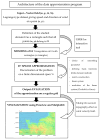A Mathematical Model for Wind Velocity Field Reconstruction and Visualization Taking into Account the Topography Influence
- PMID: 39590750
- PMCID: PMC11595753
- DOI: 10.3390/jimaging10110285
A Mathematical Model for Wind Velocity Field Reconstruction and Visualization Taking into Account the Topography Influence
Abstract
In this paper, we propose a global modelling for vector field approximation from a given finite set of vectors (corresponding to the wind velocity field or marine currents). In the modelling, we propose using the minimization on a Hilbert space of an energy functional that includes a fidelity criterion to the data and a smoothing term. We discretize the continuous problem using a finite elements method. We then propose taking into account the topographic effects on the wind velocity field, and visualization using a free library is also proposed, which constitutes an added value compared to other vector field approximation models.
Keywords: current/wind velocity field approximation; vector flow visualization; wind velocity field modelling.
Conflict of interest statement
The authors declare no conflicts of interest.
Figures



















References
-
- Gout C., Lambert Z., Apprato D. Data Approximation: Mathematical Modelling and Numerical Simulations. EDP Sciences; Les Ulis, France: 2019. 168p.
-
- Dzhabrailov A.S., Klochkov Y.V., Marchenko S.S., Nikolaev A.P. The finite element approximation of vector field in curvilinear coordinates. Russ. Aeronaut. 2007;50:115–120. doi: 10.3103/S1068799807020018. - DOI
-
- Benbourhim M.N., Bouhamidi A. Approximation of vector fields by thin plate splines with tension. J. Approx. Theory. 2005;136:198–229. doi: 10.1016/j.jat.2005.07.005. - DOI
-
- Benbourhim M.N., Bouhamidi A. Pseudo-polyharmonic vectorial approximation for div-curl and elastic semi-norms. Numer. Math. 2008;109:333–364. doi: 10.1007/s00211-008-0146-x. - DOI
-
- Dodu F., Rabut C. Vectorial interpolation using radial-basis-like functions. Comput. Math. Appl. 2002;43:393–411. doi: 10.1016/S0898-1221(01)00294-2. - DOI
LinkOut - more resources
Full Text Sources

